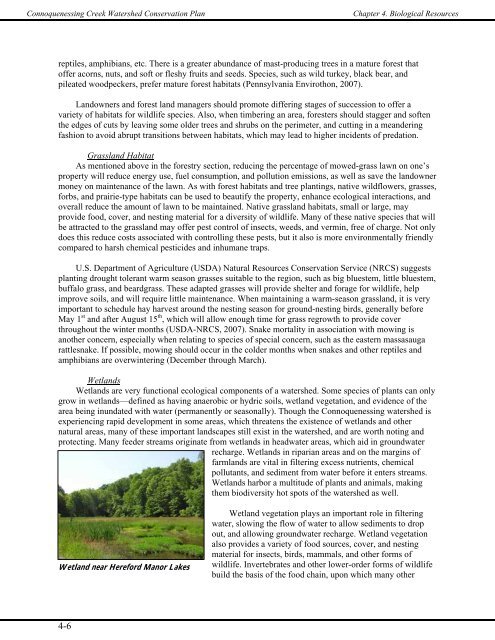CHAPTER 4 - Western Pennsylvania Conservancy
CHAPTER 4 - Western Pennsylvania Conservancy
CHAPTER 4 - Western Pennsylvania Conservancy
You also want an ePaper? Increase the reach of your titles
YUMPU automatically turns print PDFs into web optimized ePapers that Google loves.
Connoquenessing Creek Watershed Conservation Plan<br />
Chapter 4. Biological Resources<br />
reptiles, amphibians, etc. There is a greater abundance of mast-producing trees in a mature forest that<br />
offer acorns, nuts, and soft or fleshy fruits and seeds. Species, such as wild turkey, black bear, and<br />
pileated woodpeckers, prefer mature forest habitats (<strong>Pennsylvania</strong> Envirothon, 2007).<br />
Landowners and forest land managers should promote differing stages of succession to offer a<br />
variety of habitats for wildlife species. Also, when timbering an area, foresters should stagger and soften<br />
the edges of cuts by leaving some older trees and shrubs on the perimeter, and cutting in a meandering<br />
fashion to avoid abrupt transitions between habitats, which may lead to higher incidents of predation.<br />
Grassland Habitat<br />
As mentioned above in the forestry section, reducing the percentage of mowed-grass lawn on one’s<br />
property will reduce energy use, fuel consumption, and pollution emissions, as well as save the landowner<br />
money on maintenance of the lawn. As with forest habitats and tree plantings, native wildflowers, grasses,<br />
forbs, and prairie-type habitats can be used to beautify the property, enhance ecological interactions, and<br />
overall reduce the amount of lawn to be maintained. Native grassland habitats, small or large, may<br />
provide food, cover, and nesting material for a diversity of wildlife. Many of these native species that will<br />
be attracted to the grassland may offer pest control of insects, weeds, and vermin, free of charge. Not only<br />
does this reduce costs associated with controlling these pests, but it also is more environmentally friendly<br />
compared to harsh chemical pesticides and inhumane traps.<br />
U.S. Department of Agriculture (USDA) Natural Resources Conservation Service (NRCS) suggests<br />
planting drought tolerant warm season grasses suitable to the region, such as big bluestem, little bluestem,<br />
buffalo grass, and beardgrass. These adapted grasses will provide shelter and forage for wildlife, help<br />
improve soils, and will require little maintenance. When maintaining a warm-season grassland, it is very<br />
important to schedule hay harvest around the nesting season for ground-nesting birds, generally before<br />
May 1 st and after August 15 th , which will allow enough time for grass regrowth to provide cover<br />
throughout the winter months (USDA-NRCS, 2007). Snake mortality in association with mowing is<br />
another concern, especially when relating to species of special concern, such as the eastern massasauga<br />
rattlesnake. If possible, mowing should occur in the colder months when snakes and other reptiles and<br />
amphibians are overwintering (December through March).<br />
Wetlands<br />
Wetlands are very functional ecological components of a watershed. Some species of plants can only<br />
grow in wetlands—defined as having anaerobic or hydric soils, wetland vegetation, and evidence of the<br />
area being inundated with water (permanently or seasonally). Though the Connoquenessing watershed is<br />
experiencing rapid development in some areas, which threatens the existence of wetlands and other<br />
natural areas, many of these important landscapes still exist in the watershed, and are worth noting and<br />
protecting. Many feeder streams originate from wetlands in headwater areas, which aid in groundwater<br />
recharge. Wetlands in riparian areas and on the margins of<br />
farmlands are vital in filtering excess nutrients, chemical<br />
pollutants, and sediment from water before it enters streams.<br />
Wetlands harbor a multitude of plants and animals, making<br />
them biodiversity hot spots of the watershed as well.<br />
Wetland near Hereford Manor Lakes<br />
Wetland vegetation plays an important role in filtering<br />
water, slowing the flow of water to allow sediments to drop<br />
out, and allowing groundwater recharge. Wetland vegetation<br />
also provides a variety of food sources, cover, and nesting<br />
material for insects, birds, mammals, and other forms of<br />
wildlife. Invertebrates and other lower-order forms of wildlife<br />
build the basis of the food chain, upon which many other<br />
4-6














